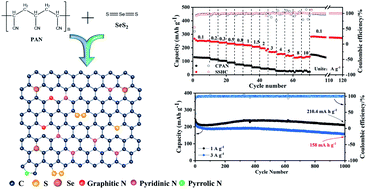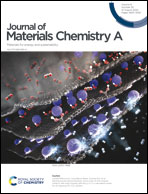Facile and scalable synthesis of a sulfur, selenium and nitrogen co-doped hard carbon anode for high performance Na- and K-ion batteries†
Abstract
Hard carbon is the most attractive anode material for sodium/potassium-ion storage, because of its extensive resources, low cost, and environmental benignity. However, it is a great challenge to design carbon-based anodes with a high capacity and long lifespan. Herein, sulfur, selenium and nitrogen co-doped hard carbon was prepared via a facile and scalable solid reaction and used as the anode material for sodium/potassium-ion batteries. It shows a superior sodium storage performance, with outstanding rate performance (125.9 mA h g−1 at a high rate of 10 A g−1) and good cycling stability (210.4 mA h g−1 at 1 A g−1 after 1000 cycles), which surpass those of most reported hard carbons. When used for KIBs, it displays a high capacity of 207 mA h g−1 at 0.1 A g−1 after 450 cycles. An excellent rate capability (158.1 mA h g−1 at 3 A g−1) and remarkable capacity retention of 143.5 mA h g−1 after 1100 cycles at 1 A g−1 can also be achieved. Furthermore, the kinetic analyses of Na+ and K+ storage reveal that the capacitive charge storage accounts for the excellent rate performance. The facile synthetic route and excellent ion storage properties make the as-prepared material a promising anode material for alkali metal ion batteries.

- This article is part of the themed collection: Journal of Materials Chemistry A HOT Papers


 Please wait while we load your content...
Please wait while we load your content...